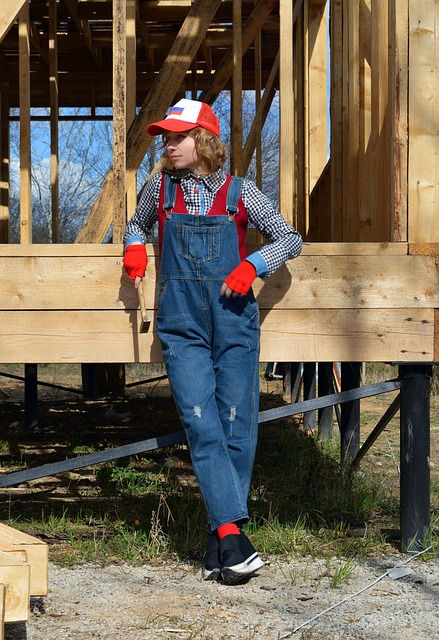Residential foundation repair is crucial for maintaining home structural integrity, preventing costly damages, and ensuring safety. Common issues like cracks, uneven floors, and settlement indicate problems with soil conditions, construction, or weather events. Regular inspections using advanced tools like GPR detect these issues early. Repair methods range from crack sealing to underpinning, with cost varying by damage extent and technique. Choosing experienced professionals with transparent pricing is key. Post-repair maintenance, including regular inspections and drainage management, safeguards the foundation's longevity.
A solid home foundation is non-negotiable, yet many homeowners overlook its health until issues arise. This comprehensive guide dives into the essentials of residential foundation repair, empowering you with knowledge. We explore the basic principles behind foundation repair, highlighting the importance of regular health checks.
Learn to identify common signs of distress, understand various foundation problems and their implications, and navigate the inspection process using modern tools and techniques. Additionally, we’ll guide you through cost estimates, selection of experts, and post-repair care for a lasting solution.
Understanding Residential Foundation Repair: The Basics

Residential foundation repair is a critical aspect of maintaining a home’s structural integrity and longevity. It involves assessing and rectifying issues with the base of a residence, which can be affected by various factors such as soil conditions, improper construction, settlement, or extreme weather events. The initial step in this process is often a thorough inspection to identify problem areas, like cracks in the foundation walls or uneven floors.
Once these issues are pinpointed, specialized contractors employ various techniques to fix them, ensuring the stability and safety of the structure. This can include methods like underpinning (adding support beams), piecing (repairing cracks with specialized materials), or even full foundation replacement. Regular checks and prompt action regarding residential foundation repair are key to preventing more severe damage and costly renovations in the future.
Importance of Regular Foundation Health Checks

Regular foundation health checks are an essential part of maintaining any residential property. A home’s foundation is its critical support system, bearing the weight of the entire structure and transferring it to the soil beneath. Over time, various factors like shifting soil, extreme weather events, and normal wear and tear can weaken a foundation, leading to costly repairs or even structural damage if left unchecked.
A comprehensive foundation health check identifies potential problems early on, allowing for prompt addressing before they escalate. This proactive approach saves homeowners money in the long run by preventing the need for extensive residential foundation repair later. By scheduling regular inspections, homeowners can ensure their investment is protected and maintain a safe, stable living environment.
Common Signs Your Home's Foundation Needs Repair

If your home is showing signs of structural issues, it could be an indication that your foundation requires repair. Some common indicators include noticeable cracks on the walls or floors, especially those that are wider than 1/8th of an inch. Unlevel or uneven floors can also suggest a problem, as can doors and windows that stick or do not close properly. Water damage is another red flag; if you notice persistent moisture or water seepage in your basement or crawl space, it could compromise the integrity of your foundation.
Bulging walls, sinks, or uneven ceilings are additional visual cues that may point to a failing foundation. If you experience frequent noises like creaking or groaning from your walls or floors, this could be an early warning sign. Over time, these issues can lead to more severe structural damage, making it crucial to address them promptly. Residential Foundation Repair is essential for maintaining the safety and stability of your home.
Types of Foundation Issues and Their Impact

Foundation issues can manifest in various forms, each with its unique impact on a structure, particularly in residential areas. One common type is cracking, which can appear as hairline fractures or larger gaps. These cracks may seem innocuous but can indicate underlying problems like settlement, heave, or shift due to soil conditions or poor construction practices. Over time, these issues compound, leading to more severe structural damage and potential safety hazards.
Another significant foundation problem is uneven settling, often visible through warped floors, sloping walls, or doors that stick. This can be caused by weak soil bearing capacity, inadequate foundation support systems, or changes in moisture levels beneath the structure. Such imbalances not only affect the aesthetic appeal of a home but also compromise its structural integrity, potentially leading to costly residential foundation repair requirements.
The Process of Conducting a Comprehensive Foundation Inspection

Conducting a comprehensive foundation inspection for residential properties involves a meticulous process designed to identify potential issues that could lead to costly repairs down the line. It begins with a visual examination, where experts inspect visible signs of damage or settlement, checking cracks in foundations, walls, and floors, as well as any uneven flooring or sagging doors. This initial step provides valuable insights into the overall health of the structure.
Subsequent to the visual assessment, non-invasive testing methods are employed. These include moisture meter readings to detect water intrusion, which could indicate potential structural problems. Additionally, ground penetration radar (GPR) is utilized to create detailed images of the foundation, revealing any anomalies beneath the surface. This comprehensive approach ensures that every aspect of the residential foundation repair is thoroughly evaluated, allowing for timely interventions and minimizing future disruptions.
Tools and Technologies Used in Foundation Evaluation

When assessing a residential foundation repair, modern tools and technologies play a pivotal role in ensuring accurate evaluations. One such tool is ground-penetrating radar (GPR), which uses electromagnetic waves to create detailed images of underground structures. This non-invasive method allows professionals to detect anomalies in the foundation without disrupting the surrounding environment. Additionally, digital cameras with high-resolution capabilities and thermal imaging technology offer valuable insights into cracks, shifts, and moisture issues that might be invisible to the naked eye.
Advanced software applications also facilitate comprehensive analysis by integrating data from various sensors and scans. These tools can predict potential structural problems, enabling proactive Residential Foundation Repair measures. Furthermore, 3D modeling software creates precise digital replicas of the foundation, aiding in visualizing and communicating repair needs to both clients and contractors. With these technologies, evaluations become more efficient, accurate, and effective, ultimately leading to better-informed decisions for maintaining or repairing residential foundations.
Cost Considerations for Foundation Repair Options

When considering residential foundation repair options, cost is a significant factor that homeowners should evaluate carefully. The expense associated with repairing a foundation can vary greatly depending on several factors, including the extent of damage, the chosen repair method, and local labor rates. It’s essential to understand that some repairs may only require minor interventions, such as crack sealing or piering, while others might involve more extensive work like underpinning or even complete foundation replacement. These variations directly impact the financial burden, with costs ranging from a few hundred to several thousand dollars.
Homeowners should obtain quotes from reputable contractors to get a clear picture of the potential expenses. Compare different estimates and consider not only the cost but also the reputation and experience of the contractor. Additionally, exploring financing options or discussing budget-friendly solutions with professionals can help make residential foundation repair more accessible. Remember, addressing foundation issues early is key to preventing further damage and ensuring a safe living environment.
Choosing the Right Foundation Repair Professionals

When considering residential foundation repair, selecting the right professionals is paramount. Look for a company with extensive experience in various foundation repair techniques, including underpinning, piering, and slab jacking. Check their credentials, licenses, and insurance to ensure they meet industry standards. Online reviews from previous clients can also provide valuable insights into their reputation and service quality.
Reputable foundation repair specialists should offer free estimates and inspections without any pressure to make an immediate decision. They should be able to clearly explain the problem, propose suitable solutions, and provide transparent pricing. Effective communication and a thorough understanding of your concerns are essential indicators of a reliable and trustworthy contractor for your residential foundation repair needs.
Post-Repair Maintenance: Ensuring Long-Term Health

After a residential foundation repair, proper post-repair maintenance is crucial for ensuring long-term health and stability of the structure. This includes regular inspections to monitor any signs of new damage or settling, as well as timely addressing of issues like cracks, unevenness, or moisture intrusion. Homeowners should also maintain proper drainage around their properties to prevent water from pooling near the foundation, which can lead to further damage over time.
Regular maintenance tasks such as re-sealing cracks, repainting the foundation, and ensuring all doors and windows are properly sealed contribute to preserving the integrity of the repair work. Additionally, keeping trees and shrubs trimmed back from the foundation helps prevent root systems from causing future disturbances, promoting a healthier and more stable environment for the structure’s long-term survival.
